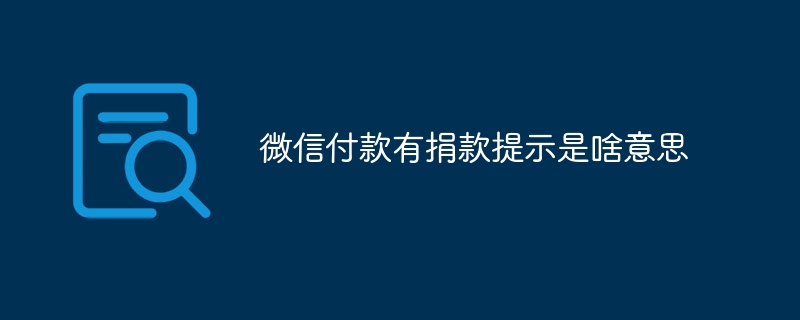Home >Common Problem >What does the donation prompt on WeChat payment mean?
What does the donation prompt on WeChat payment mean?
- 百草Original
- 2023-09-22 13:33:172171browse
WeChat payment has a donation prompt, which means that during the WeChat payment process, when the user pays a merchant or individual, WeChat will prompt the user whether he is willing to donate part of the amount as a donation to a charity or public welfare project. When users use WeChat Pay to make payments, they can choose whether to check the donation option and set the donation amount or select the donation proportion. The existence of this donation prompt helps to improve users' social awareness and participation, facilitates users to donate, and increases Concern and support for public welfare undertakings.

The donation prompt for WeChat payment means that during the WeChat payment process, when the user pays a merchant or individual, WeChat will prompt the user whether he or she is willing to donate part of the amount as Donate to charity or public welfare projects. This is a social responsibility function provided by the WeChat payment platform to encourage users to participate in public welfare undertakings and contribute to society.
When a user chooses to use WeChat Pay for payment, if the merchant or individual has activated the donation function, a donation prompt box will appear on the WeChat Payment interface. Users can choose whether to check the donation option according to their own wishes, and set the donation amount or select the donation proportion. Once the user checks the donation option and completes the payment, the corresponding amount will be donated to the designated charity or public welfare project.
The existence of this donation reminder has the following meanings and functions:
1. Social responsibility: As a social and payment platform, WeChat encourages users to participate in public welfare undertakings by providing a donation reminder function , convey social responsibility. This helps to increase users’ social awareness and participation and promote the development of public welfare undertakings.
2. Convenient donation: The donation reminder function allows users to conveniently make donations during the payment process without additional operations and processes. This provides users with a simple and convenient way to support charities and public welfare projects.
3. Transparency and trust: The WeChat payment platform will openly and transparently show users the specific amount and whereabouts of donations to ensure the transparency and traceability of donations. This helps build user trust in the platform and increases user confidence in the use of donations.
4. Charity promotion: Through donation reminders, the WeChat payment platform can also publicize and promote specific charities or public welfare projects to users. Users can learn more public welfare information and increase their attention and support for public welfare undertakings.
It should be noted that the donation prompt is optional, and users have the right to choose whether to participate in donation. The WeChat payment platform respects users' choices and privacy and will not force users to make donations. Users can decide whether to participate in donations based on their own wishes and financial capabilities.
To sum up, the donation reminder for WeChat payment is a social responsibility function provided by the WeChat payment platform, aiming to encourage users to participate in public welfare undertakings. When users use WeChat Pay to pay, they can choose whether to check the donation option, set the donation amount, or select the donation proportion. The existence of this kind of donation prompt helps to increase users' social awareness and participation, facilitates users to make donations, and increases attention and support for public welfare undertakings.
The above is the detailed content of What does the donation prompt on WeChat payment mean?. For more information, please follow other related articles on the PHP Chinese website!
Related articles
See more- What shopping platforms support WeChat payment?
- BMW China makes an emergency donation of 15 million yuan to support flood prevention and rescue work in Beijing
- NetEase's mobile game 'Ni Shui Han' launched a charity campaign for floods in the Beijing-Tianjin-Hebei region, with total donations reaching 3 million yuan
- Using WordPress to collect donations: Bitcoin

